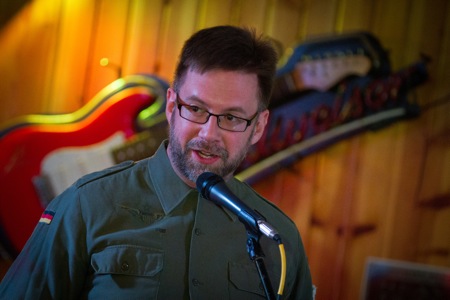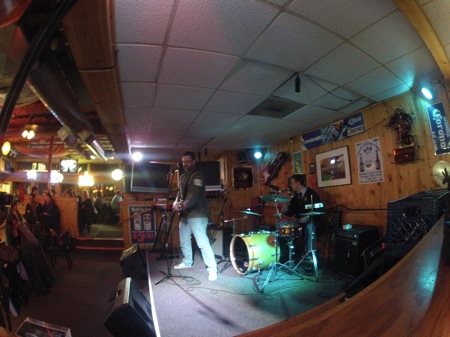In the interest of promoting
Linked Open Data, Punk Archaelogy, and recursion, I repost here the full text of Andrew Reinhard's contribution to Bill Caraher's blog
The Archaeology of the Mediterranean World recapitulating last week's
Linked Ancient World Data Institute.
Andrew Reinhard gives us the scoop on the punk mentality and linked data practices in archaeology.
So on Tuesday, I had a sweet guest blogger and people really liked it.
So when Andrew Reinhard (a punk archaeologist of the highest order)
wanted to post something here, I not only couldn’t say “no”, but I
couldn’t say YES fast enough. And when he wanted to talk about what he
learned at the Linked Ancient World Data Institute (#LAWDI), I was all
in.
(This is the SECOND time in less than 6 months that I’ve been lucky
enough to introduce Andrew to the uninitiated (which I was as well about
8 months ago)).
 Punk Archaeology 2013. Photograph by Timothy Pasch.
Punk Archaeology 2013. Photograph by Timothy Pasch.
So here are Andrew Reinhard’s thoughts on linked archaeology and punk archaeology:
“The idea that there’s such a thing as ‘final publication’ of archaeological material is bullshit.”
I said this to a room full of colleagues all of whom had a stake in
the new-new thing: Linked Ancient World Data (or LAWD). The cool thing?
Nobody disagreed.
The Linked Ancient World Data Institute
(#lawdi) was an open source love-in funded by an NEH Digital Humanities
grant spread over two spring, 3-day sessions. The first session was
held in 2012 at the Institute for the Study of the Ancient World (ISAW)
in New York City, and the second concluded this past Saturday, June
1st, at Drew University in Madison, New Jersey. LAWDI, the collective
brainchild of Sebastian Heath, Tom Elliott, and John Muccigrosso, was
created to bring together a diverse and progressive band of scholars,
librarians, and museum professionals of the ancient world, many of whom
were also technologists, to explore the nature of Linked Open Data (LOD)
as it relates to antiquity and how to share it across the Internet.
Ours was a multinational, happy band, female and male, older and
younger, tool-builders and tool-users, some with projects completed, and
others with projects just underway, some facile with the finer points
of RDF and SPARQL,
others not so much, yet all demonstrated good faith in the belief that
we could help each other learn. And link. There were no Luddites here.
There were only LAWDites.
Assaulted by unseasonable heat and humidity, we embraced “Digital
Humanities chic”—cargo shorts and tshirts, flip-flops and sandals. This
was Open Access fantasy camp fueled by coffee and alcohol. Run more like
a workshop than a formal conference, papers were replaced largely by
practice, jumping in feet first to understand what RDF is, what the
difference is between a URI and a URL, how to mint URIs, how to make
archaeological data discoverable and usable. “My data is your data, and
your data is my data,” Tom Elliott said in 2012.
We followed the Freirean model of student-teachers and
teacher-students, each learning from the other. Numismatists like Andrew
Meadows and Ethan Gruber demonstrated the open data masterpiece that is
Nomisma.org, while Dan Pett of the British Museum modeled his Portable Antiquities Scheme
as a crowd-assisted project. Chuck Jones of the ISAW library discussed
its digital collection practices and followed up with an Open Access
tour de force via the Ancient World Online’s collection of over 1,200 OA journals on antiquity worldwide. Eric Kansa demoed his OpenContext.org
site for hosting and sharing archaeological projects and there data.
Sebastian Heath and I attacked issues in archaeological publication from
two fronts, Heath by way of XML, HTML, and ISAW Papers, and me by way of making digital, linkable content available alongside traditional print publication.
Parts of each day were dedicated to “student” presentations, where
both nascent and established projects in linked archaeological data were
showcased, many of which came prepared with questions ranging from how
to prepare data for global consumption, to how to link to established
online geographical tools like Pleiades and Pelagios,
and beyond. William Murray discussed his 3D project with ships’
battering rams used in the Battle of Actium. Rebecca Benefiel and Sara
Sprenkle presented their prototype of a new web application involving
the ancient graffiti of Pompeii. Katy Meyers argued for the need for
open data in bioarchaeological collections and mortuary site datasets to
avoid a sampling bias that limits interpretation of that data. There
were a dozen more presentations like these on interesting, useful
projects.
Each speaker came ready to share, ready to ask questions, and ready
to receive help. The spirit of LAWDI created an incredibly supportive
environment that allowed for free (and ego-free) dialogue about what to
do with archaeological data not just to bring it into the world,
rescuing it from inside a silo or behind a paywall, but also how to
connect with tools and websites already in use in order to make data on
anything from findspots to artifact types to cuneiform inscriptions more
open and more useful in ways the holders of that data might not have
even imagined.
Dinners and late-night hack-a-thons followed each day’s sessions,
with smaller groups spiralling off to attack specific problems of
ancient geography or naming authorities with code, or to discuss
problems of archaeological data in a more theoretical way, supplemented
with breaks in the action for air-guitar, rugby scores, and beer-runs.
By the end of the BBQ on the final day, our brains were beyond full, but
the inertia and creativity driven by the constant conversation carried
all of us home to immediately begin working on existing projects and the
next, new-new things for our respective disciplines.
If the above doesn’t sound “punk-rock”, it should. We turned the
traditional conference structure on its ear and skanked on its head.
Most people in the room over those three days had already embraced the
DIY (do-it-yourself) attitude shared by all punks. If a tool doesn’t
exist, build it. If you have a question, ask it. If you can help
somebody, do it. The spirit of community was evident, and all LAWDites
formed a tight bond by the end with the sense that we’re all in this
together, and what we’re doing is for the greater good.
Many projects are either under-funded or are done for free,
hand-coded in basements late at night or early in the morning, at times
built with tools never intended for the purpose to which they were put. A
big part of Punk is making noise with the instruments you have,
learning by playing, and getting better by playing with others.
Creativity thrives when there’s no money, and the Punk attitude drives
us to find ways around these restrictions, often creating better, leaner
end-products than if we’d had a bottomless pool of resources, time, and
materials. We build because we have to. And we recognize the problems
inherent in ransomed scholarship and in the old ways of thinking about
archaeological data and how that data is/are made available. It’s Punk
to question authority. It’s Punk to question the establishment. It’s
Punk to question the status quo. We don’t do it to be subversive (most
of the time). We do it because we feel there is a better way to go about
the business of sharing information openly, and making that information
easily discoverable and hopefully easy to use. It’s not about the
money, and it’s not about the notoriety. But it is about the big picture
and how we want to see the world. We live in it, and therefore we have a
voice to change it if we want. That’s Punk. And that’s Linked Ancient
World Data.
When I said that the concept of “final publication of archaeological
material” is “bullshit”, I meant it with every cell in my body.
Publication of archaeological data is the conversation-starter. While it
might mark the end of the push for tenure, or the conclusion of the
analysis of a pottery assemblage or hoard of coins, the publication
contains the synthesis and ideas of only one author (or perhaps a
handful). Who knows what other information can be gleaned by another set
of eyes, another brain. How can that data be re-assessed, re-mixed,
re-used, recycled? That questioning, that reconsideration is how we move
our field(s) forward, and is how science works (or is supposed to
work). And it’s also how Punk works. By checking our egos at the door
when we submit our research, we can engage in an open and constructive
dialogue with our current peers and those who come after, and our ideas
on the ancient world will become more focused and occasionally
overturned from those critical questions we weren’t afraid to ask.
Now that the Linked Ancient World Data Institute is formally complete
with both 3-day sessions behind us, all participants find themselves at
the vanguard of a Punk Archaeology movement. Join us online as part of
the Linked Ancient World Data Initiative. Details of more formal meetups
and hangouts, plus informal gatherings be they real or virtual, online
or in London or New York or elsewhere, will become available soon and
throughout the coming months. Better yet, don’t wait for these to
happen. Do it yourselves. Use the #lawdi hashtag on Twitter. Subscribe
to the Ancient World Online. Read the ISAW Papers. Google “Linked
Ancient World Data” or “LAWD” or “AWLD”. You’ll find us. Be a punk. Join
the initiative, and help create the new status quo of open, free, and
shared archaeological data.
NOTE: I’ll update this post via the Comments area once the 2013 LAWDI
program is open, as well as the Twitter archive and collection of links
to get readers started.
Andrew
 Andrew’s less mild-mannered persona. Photograph by Chad Bushy.
Andrew’s less mild-mannered persona. Photograph by Chad Bushy.
Punk Archaeology 2013. Photograph by Timothy Pasch.
Andrew’s less mild-mannered persona. Photograph by Chad Bushy.









 Stumble It!
Stumble It!

No comments:
Post a Comment